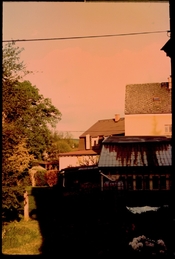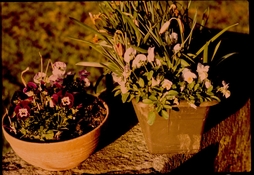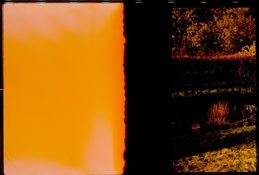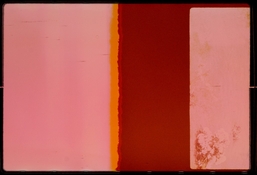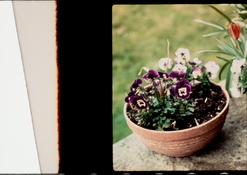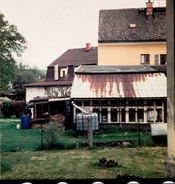I'm working on my own alternative color reversal process for developing E-6 films. Idea behind is to avoid expensive E-6 kit or expensive lab processing, while being as simple as possible.
For my experiments I use some ready-made BW positive high-contrast developer Foma GD-L as first developer, homemade RA-4 developer as color developer (formula from Bonavolta), homemade ferricyanide bleach and ready-made rapid fixer. Reexposure is done with light.
Film used is Kodak Ektachrome E100.
After some initial fails (pictures almost black) I came to results which already show some color image, but with heavy orange cast, see photos.
I used this process:
0. Exposure in camera (accidentaly exposed at 200ASA)
1. Foma GD-L developer solution 1+4 with 2g potassium thiocyanate per litre - 6 min. at 40°C
2. Wash with lukewarm water - 2 min
3. Reexposure under 100W bulb in cca 10cm distance - 5 min
3. Reexposure under 11W 4000K LED bulb in cca 10cm distance - 3 min
4. RA-4 color developer (Bonavolta formula) - 6 min at 40°C
5. Wash with lukewarm water - 2 min
6. Ferricyanide bleacher - 5 min at 40°C
7. Wash with lukewarm water - 2 min
8. Rapid fixer - 3 min at 40°C
9. Wash with lukewarm water
In the images we can see heavy orange cast/fog. This cast is also present at the film tail, which was heavily exposed with daylight - see pic.
Question is what to do to be fog-free.
In the exposed tail is visible, that the cast is not uniform and is less near the edges of the film and in the middle is stronger. This suggests that maybe agitation during 1st development was insufficient - I used agitation 10sec every minute, which is maybe too little as in reversal development the reaction is much stronger than at negative development.
But I feel that even at stronger agitation the cast will probably still be there.
I am unable to isolate the problem. Do I need longer 1st development? More thiocyanate? Unsuitable formulation of the 1st developer? More light? Or do I need something to do with color dev? For instance Kodak recipe puts thiocyanate also into color dev...
For my experiments I use some ready-made BW positive high-contrast developer Foma GD-L as first developer, homemade RA-4 developer as color developer (formula from Bonavolta), homemade ferricyanide bleach and ready-made rapid fixer. Reexposure is done with light.
Film used is Kodak Ektachrome E100.
After some initial fails (pictures almost black) I came to results which already show some color image, but with heavy orange cast, see photos.
I used this process:
0. Exposure in camera (accidentaly exposed at 200ASA)
1. Foma GD-L developer solution 1+4 with 2g potassium thiocyanate per litre - 6 min. at 40°C
2. Wash with lukewarm water - 2 min
3. Reexposure under 11W 4000K LED bulb in cca 10cm distance - 3 min
4. RA-4 color developer (Bonavolta formula) - 6 min at 40°C
5. Wash with lukewarm water - 2 min
6. Ferricyanide bleacher - 5 min at 40°C
7. Wash with lukewarm water - 2 min
8. Rapid fixer - 3 min at 40°C
9. Wash with lukewarm water
In the images we can see heavy orange cast/fog. This cast is also present at the film tail, which was heavily exposed with daylight - see pic.
Question is what to do to be fog-free.
In the exposed tail is visible, that the cast is not uniform and is less near the edges of the film and in the middle is stronger. This suggests that maybe agitation during 1st development was insufficient - I used agitation 10sec every minute, which is maybe too little as in reversal development the reaction is much stronger than at negative development.
But I feel that even at stronger agitation the cast will probably still be there.
I am unable to isolate the problem. Do I need longer 1st development? More thiocyanate? Unsuitable formulation of the 1st developer? More light? Or do I need something to do with color dev? For instance Kodak recipe puts thiocyanate also into color dev...
Attachments
Last edited:








